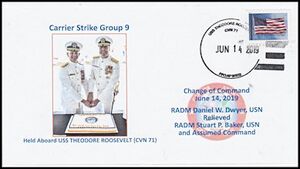OtherUS Carrier Strike Group Nine
Cachets should be listed in chronological order based on earliest known usage. Use the postmark date or best guess. This applies to add-on cachets as well.
CARRIER STRIKE GROUP NINE History
USS Coontz flew the flag of the Commander, Cruiser-Destroyer Flotilla 11 from 1 August to 11 November 1962.
Effective 30 June 1973, Commander Cruiser Destroyer Flotilla 11 was re-designated as Commander Cruiser-Destroyer Group Three (CCDG-3). USS Gridley was part of Cruiser-Destroyer Group Three in 1975. In 1978, the Group directed Destroyer Squadron 7, Destroyer Squadron 17, and Destroyer Squadron 27 (Naval Reserve Force), all at San Diego. On 10 December 1981, the group staff embarked on board the aircraft carrier USS Ranger to prepare for its first Carrier Battle Group deployment. Since that date, deployments have been made on the USS Kitty Hawk, USS Enterprise, USS Nimitz, and USS Carl Vinson.
Rear Admiral Jonathan Howe commanded the group in 1984–86. During 1986, USS Enterprise's battle group deployment was directed by Commander Cruiser-Destroyer Group Three.
In early 1991, Rear Admiral P. M. Quast, Commander, Cruiser-Destroyer Group Three, led Battle Group Bravo on deployment to the Middle East. The group consisted of USS Nimitz, USS Texas, USS Rentz, USS Stein, USS Harold E. Holt, USS Camden, and USS Chancellorsville, along with Commander, Destroyer Squadron 21 and Carrier Air Wing Nine embarked in USS Nimitz.
In April 1992, the Navy implemented the 'core battle group' concept. From this point each carrier battle group was planned to consist of an aircraft carrier; an embarked carrier air wing; cruisers, destroyers, and frigates; and two nuclear-powered attack submarines. This reorganization set off a round of ship arrivals and reassignments for the group. From April 1992 the group was assigned as permanent Immediate Superior in Command for USS Antietam, USS Arkansas, and USS Vincennes. USS England was assigned to CCDG-3, but was decommissioned in January 1994. In August 1992, USS Carl Vinson and Carrier Air Wing Fourteen were added, and CCDG-3 took on the additional title of Commander, Carl Vinson Battle Group. In October 1992, Surface Squadron 5 was redesignated Destroyer Squadron 5 and assigned under CCDG-3. The addition of USS Cushing, USS Harry W. Hill, USS Fletcher, and USS Reuben James rounded out the Vinson Battle Group's forces. In December 1992, two submarines, USS San Francisco and USS Asheville were added. USS Lake Erie joined the group in March 1993 and USS Russell joined in September 1994.
The group completed a very successful deployment to the Persian Gulf in August 1994. In January 1996, the Carl Vinson Battle Group was redesignated the Carl Vinson Task Group, and Destroyer Squadron 5 was reassigned to Naval Surface Group Middle Pacific in Hawaii on 1 February 1996.[10] The Carl Vinson Task Group successfully completed all predeployment examinations and deployed in May 1996 with USS Carl Vinson, USS Shiloh, USS Arkansas, USS California, USS Crommelin, USS Camden, USS Hawkbill, USS Jefferson City, and Carrier Air Wing Fourteen.
In June 1998 CCDG-3 deployed to the Persian Gulf. The deployment was the first on board the USS Abraham Lincoln. On 20 August 1998, the group took part in Operation Infinite Reach, launching Tomahawk cruise missiles against the Sudanese Al-Shifa pharmaceutical factory. This factory was suspected of assisting Osama Bin Laden in making chemical weapons. The Battle Group also launched a second wave of Tomahawk cruise missiles against Bin Laden's terrorist training camps in Afghanistan. These cruise missile strikes were ordered by President Bill Clinton 13 days after terrorists bombed the U.S. embassies in Kenya and Tanzania. Rear Admiral Kevin Green transferred command of the group to incoming Rear Adm. Phillip Balisle on 3 December 1999, aboard the flagship USS Abraham Lincoln.
In 2002, the battle group deployed to the Persian Gulf to fly operations over Afghanistan the group carried out combat operations against Iraqi military forces during the 2003 invasion of Iraq.
The Abraham Lincoln Carrier Battle Group received a Navy Unit Commendation (NUC) for its support of Operation Enduring Freedom, Operation Southern Watch, and Operation Iraqi Freedom during the period of 1 September 2001 to 30 April 2003, completing of an overseas deployment of 290 days. The Battle Group received its second NUC as part of the U.S. Fifth Fleet's battle/strike force, Task Force 50, during August 1998, and it received its third NUC for operations between 4 March to 1 May 2003.
The battle group also received a Meritorious Unit Commendation (MUC) for its support of Operation Southern Watch during the period of 11 June to 11 December 1998, in which was also included its support of Operation Infinite Reach. The Battle Group received a second MUC for its operations during the period of 1 January 1999 to 10 September 2001, including OSW air combat operations.
On 1 October 2004, Cruiser-Destroyer Group Three was re-designated as Carrier Strike Group 9.
| Thumbnail Link To Cachet Close-Up Image | Thumbnail Link To Full Cover Front Image | Thumbnail Link To Postmark or Back Image | Postmark Date Postmark Type Killer Bar Text Ship --------- Category |
|---|
|
N/A |
 |
N/A |
2004-10-01 |
|
Unit Logo |
Note:
|
N/A |
 |
N/A |
2019-06-14 |
|
Change of Command |
Cachet by Neal J. Mills
If you have images to add to this page, then either contact the Curator or edit this page yourself and add them. See Editing Cachet Maker Pages for detailed information on editing this page.
Copyright 2025 Naval Cover Museum